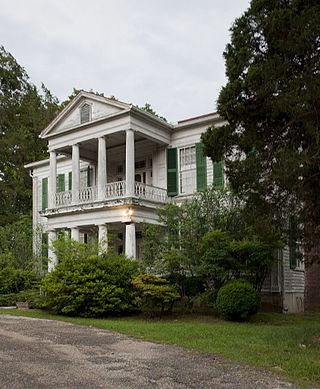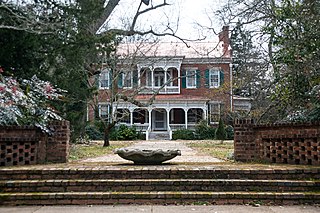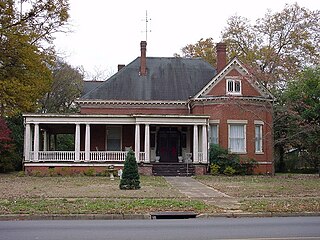
Cahaba, also spelled Cahawba, was the first permanent state capital of Alabama from 1820 to 1825, and the county seat of Dallas County, Alabama until 1866. Located at the confluence of the Alabama and Cahaba rivers, it suffered regular seasonal flooding.

William Parish Chilton was an American politician and author who served as a Deputy from Alabama to the Provisional Congress of the Confederate States from 1861 to 1862.

Bluff Hall is a historic residence in Demopolis, Alabama, United States. The original portion of the house is in the Federal style with later additions that altered it to the Greek Revival style. It was documented as part of the Historic American Buildings Survey in 1936, and added to the National Register of Historic Places in 1970. It serves as a historic house museum, with the interior restored to an 1850s appearance.

Gaineswood is a plantation house in Demopolis, Alabama, United States. It is the grandest plantation house ever built in Marengo County and is one of the most significant remaining examples of Greek Revival architecture in Alabama.

The Forks of Cypress was a large slave-labour cotton farm and Greek Revival plantation house near Florence in Lauderdale County, Alabama, United States. It was designed by architect William Nichols for James Jackson and his wife, Sally Moore Jackson. Construction was completed in 1830. It was the only Greek Revival house in Alabama with a two-story colonnade around the entire house, composed of 24 Ionic columns. The name was derived from the fact that Big Cypress Creek and Little Cypress Creek border the plantation and converge near the site of the main house. Although the main house was destroyed by fire in 1966 after being struck by lightning, the site was placed on the Alabama Register of Landmarks and Heritage on April 14, 1992 and the National Register of Historic Places on October 10, 1997. The site is the property of the State of Alabama; a local board has oversight.

The Conde–Charlotte House, also known as the Kirkbride House, is a historic house museum in Mobile, Alabama. The earliest section of the building, the rear kitchen wing, was built in 1822. The main section of the house was added a few decades later and is two and a half floors. The entire structure is constructed of handmade brick with a smooth stucco plaster over the exterior.

The Bragg–Mitchell Mansion, also known as the Bragg–Mitchell House, is a historic house museum in Mobile, Alabama. It was built in 1855 by Judge John Bragg and is one of the most photographed buildings in the city as well as one of the more popular tourist attractions. The house has been attributed to John's brother, a local Alabama architect, Alexander J. Bragg.

Pitts' Folly is a historic antebellum Greek Revival residence located in Uniontown, Alabama. The house was built by Philip Henry Pitts as his main house. It was designed by architect B. F. Parsons, who also designed the nearby Perry County Courthouse in Marion. Many local legends detail how the house gained its name, but they all center on the people of Uniontown believing it to be folly, or foolishness, that Pitts was building such a large house.

Rattle and Snap is a plantation estate at 1522 North Main Street in Mount Pleasant, Tennessee. The centerpiece of the estate is a mid-1840s mansion that is one of grandest expressions of the Greek Revival in Tennessee. It was designated a National Historic Landmark in 1971 for its architecture, and for its association with the Polk family, once one of eastern Tennessee's largest landowners. The house is privately owned, but may be viewed by appointment.

Magnolia Grove is a historic Greek Revival mansion in Greensboro, Alabama. The house was named for the 15-acre (6.1 ha) grove of Southern magnolias in which it stands. It was added to the National Register of Historic Places on April 11, 1973, due to its architectural and historical significance. It now serves as a historic house museum and is operated by the Alabama Historical Commission.

Glencairn, also known as the John Erwin House, is a historic house in Greensboro, Alabama, United States. The house and grounds were recorded by the Historic American Buildings Survey in 1935. The house was added to the National Register of Historic Places on January 18, 1978, due to its architectural and historical significance.

Everhope, known throughout most of its history as the Captain Nathan Carpenter House and more recently as Twin Oaks Plantation, is a historic plantation house near Eutaw, Alabama. Completed in 1853 for Nathan Mullin Carpenter, it is listed on the National Register of Historic Places and Alabama Register of Landmarks and Heritage due to its architectural and historical significance.

Bonar Hall is an 1839–40 Georgian-style house in Madison, Georgia, one of the first of the grand-style homes built during the town's cotton-boom heyday, 1840–60. It was placed on the National Register of Historic Places in 1972.

Sturdivant Hall, also known as the Watts-Parkman-Gillman Home, is a historic Greek Revival mansion and house museum in Selma, Alabama, United States. Completed in 1856, it was designed by Thomas Helm Lee for Colonel Edward T. Watts. It was added to the National Register of Historic Places on January 18, 1973, due to its architectural significance. Edward Vason Jones, known for his architectural work on the interiors at the White House during the 1960s and 70s, called it one of the finest Greek Revival antebellum mansions in the Southeast.

Miss Willie's House, also known as the Dr. Samuel Welch House, is a historic brick Queen Anne-style house in Talladega, Alabama, USA. It was built by Dr. Samuel W. Welch and his wife Ethel in 1907. Upon the deaths of Dr. Welch and his wife, the house passed to their daughter, Miss Willie Wallace Welch, who lived in the house until her death in 1997. The house is a contributing property to the "Silk Stocking District", a historic district designated in 1979 by the National Register of Historic Places in Talladega County.

The Dr. John R. Drish House, also known simply as the Drish House, is a historic plantation house in Tuscaloosa, Alabama, United States. It is considered by state preservationists to be one of the most distinctive mixes of the Greek Revival and Italianate styles in Alabama. First recorded by the Historic American Buildings Survey in 1934, it was added to the Alabama Register of Landmarks and Heritage on July 31, 1975, and subsequently to the state's "Places in Peril" listing in 2006. It was listed as Jemison School-Drish House on the National Register of Historic Places in 2015.

Alpine is a historic plantation house in Alpine, Alabama, United States. Completed in 1858, the two-story Greek Revival-style house was built for Nathaniel Welch by a master builder, Almarion Devalco Bell. The wood-frame house has several unusual features that make it one of the more architecturally interesting antebellum houses in the state. These features include the foundation materials, interior floor-plan, and the window fenestration.

Reverie is a historic Greek Revival mansion built circa 1858 in Marion, Perry County, Alabama. It now serves as a residence and also historic house museum. It is listed on the National Register of Historic Places as a contributing property to the West Marion Historic District and was recorded by the Historic American Buildings Survey. It is featured in Ralph Hammond's Antebellum Mansions of Alabama, Gregory Hatcher's Reverie Mansion and Gardens, and Jennifer Hale's Historic Plantations of Alabama's Black Belt.

The Collier–Overby House is a historic house located in Tuscaloosa, Alabama.

The Kennedy House at 607 Government Street in Mobile, Alabama, was built by local landowner Joshua Kennedy, Jr in 1857.


























